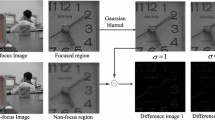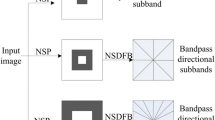Abstract
In order to further improve the contrast and sharpness of fused image, a novel multi-focus image fusion algorithm based on spatial frequency-motivated parameter-adaptive pulse coupled neural network (SF-PAPCNN) and improved sum-modified-laplacian (ISML) in nonsubsampled shearlet transform (NSST) domain is proposed in this paper. In its procedural steps, at first, the source images are decomposed into low-frequency and high-frequency components by NSST. The low-frequency components are fused by SF-PAPCNN model, the PAPCNN is designed to estimate the PCNN parameters adaptively according to the input information, and the high-frequency components are fused by ISML model. Finally, the inverse NSST is employed to the fused coefficients to reconstruct the fused image. The superiority of the proposed fusion technique is confirmed by many analytical experimentations on the gray and color multi-focus image data sets. Compared with the state-of-the-art image fusion methods, the proposed fusion algorithm has superior performance in terms of visual inspection and objective evaluation.












Similar content being viewed by others
References
Amin-Naji M, Aghagolzadeh A, Ezoji M (2019) Ensemble of CNN for multi-focus image fusion. Inf Fusion 51:201–214
Chen Y, Park S, Ma Y (2011) A new automatic parameter setting method of a simplified PCNN for image segmentation. IEEE Trans Neural Netw 22(6):880–892
Chen Y, Deng N, Xin B (2019) Nonwovens structure measurement based on NSST multi-focus image fusion. Micron 123, UNSP 102684
Chen Y, Xiong J, Xu W (2019) A novel online incremental and decremental learning algorithm based on variable support vector machine. Clust Comput 22(3):S7435–S7445
Chen Y, Xu W, Zuo J (2019) The fire recognition algorithm using dynamic feature fusion and IV-SVM classifier. Clust Comput 22(3):S7665–S7675
Chen Y, Wang J, Xia R (2019) The visual object tracking algorithm research based on adaptive combination kernel. J Ambient Intell Humaniz Comput 10(12):4855–4867
Chen Y, Wang J, Chen X (2019) Single-image super-resolution algorithm based on structural self-similarity and deformation block features. IEEE Access 7:58791–58801
Chen Y, Wang J, Liu S (2019) Multiscale fast correlation filtering tracking algorithm based on a feature fusion model. Concurr Comput Pract Exp e5533
Cunha A, Zhou J, Do M (2006) The nonsubsampled contourlet transform: theory, design, and applications. IEEE Trans Image Process 15(10):3089–3101
Do M, Vetterli M (2005) The contourlet transform: an efficient directional multiresolution image representation. IEEE Trans Image Process 14(12):2091–2106
Du C, Gao S, Liu Y (2019) Multi-focus image fusion using deep support value convolutional neural network. Optik 176:567–578
Easley G, Labate D, Lim W (2008) Sparse directional image representations using the discrete shearlet transform. Appl Comput Harmon Anal 25(1):25–46
Fan D, Lin Z, Zhao J, Liu Y (2020) Rethinking RGB-D salient object detection: models, datasets, and large-scale benchmarks. IEEE Transactions on Neural Networks and Learning Systems. (Accepted)
Fu Z, Wang X, Xu J (2016) Infrared and visible images fusion based on RPCA and NSCT. Infrared Phys Technol 77:114–123
Gu K, Wu N, Yin B (2020) Secure data query framework for cloud and fog computing. IEEE Trans Netw Serv Manag 17(1):332–345
Gu K, Wu N, Yin B, Jia W (2020) Secure Data Sequence Query Framework Based on Multiple Fogs. IEEE Trans Emerg Top Comput 8(5):1–17
Han Y, Cai Y, Cao Y (2013) A new image fusion performance metric based on visual information fidelity. Inf Fusion 14(2):127–135
He K, Sun J, Tang X (2013) Guided image filtering. IEEE Trans Pattern Anal Mach Intell 35(6):1397–1409
He K, Zhou D, Zhang X (2019) Multi-focus image fusion combining focus-region-level partition and pulse-coupled neural network. Soft Comput 23(13):4685–4699
He G, Xing S, He X (2019) Image fusion method based on simultaneous sparse representation with non-subsampled contourlet transform. IET Comput Vis 13(2):240–248
Hermessi H, Mourali O, Zagrouba E (2018) Convolutional neural network-based multimodal image fusion via similarity learning in the shearlet domain. Neural Comput Appl 30(7):2029–2045
Kong W, Lei Y (2018) Multi-focus image fusion through DCNN and ELM. Electron Lett 54(22):1282–1283
Kou F, Chen W, Wen C (2015) Gradient domain guided image filtering. IEEE Trans Image Process 24(11):4528–4539
Kumar B (2015) Image fusion based on pixel significance using cross bilateral filter. Signal Image Video Process 9(5):1193–1204
Li L, Si Y (2019) Enhancement of hyperspectral remote sensing images based on improved fuzzy contrast in nonsubsampled shearlet transform domain. Multimed Tools Appl 78(13):18077–18094
Li S, Yang B (2008) Multifocus image fusion by combining curvelet and wavelet transform. Pattern Recogn Lett 29(9):1295–1301
Li S, Kang X, Hu J (2013) Image fusion with guided filtering. IEEE Trans Image Process 22(7):2864–2875
Li Z, Zheng J, Zhu Z (2015) Weighted guided image filtering. IEEE Trans Image Process 24(1):120–129
Li W, Zhao Z, Du J (2017) Edge-preserve filter image enhancement with application to medical image fusion. J Med Imaging Health Inf 7(1):16–24
Li Q, Yang X, Wu W (2018) Multi-focus image fusion method for vision sensor systems via dictionary learning with guided filter. Sensors 18(7):2143
Li L, Si Y, Wang L, Jia Z, Ma H (2020) Brain image enhancement approach based on singular value decomposition in nonsubsampled shearlet transform domain. J Med Imaging Health Inf 10(8):1785–1794
Liu X, Xiao D (2019) Multimodality image fusion based on quantum wavelet transform and sum-modified-laplacian rule. Int J Theor Phys 58(3):734–744
Liu Y, Liu S, Wang Z (2015) A general framework for image fusion based on multi-scale transform and sparse representation. Inf Fusion 24:147–164
Liu S, Zhao J, Shi M (2015) Medical image fusion based on rolling guidance filter and spiking cortical model. Comput Math Methods Med 156043
Liu Y, Chen X, Ward R (2016) Image fusion with convolutional sparse representation. IEEE Signal Process Lett 23(12):1882–1886
Liu Y, Chen X, Peng H (2017) Multi-focus image fusion with a deep convolutional neural network. Inf Fusion 36:191–207
Liu D, Zhou D, Nie R (2018) Infrared and visible image fusion based on convolutional neural network model and saliency detection via hybrid l(0)-l(1) layer decomposition. J Electron Imaging 27(6):063036
Liu S, Wang J, Lu Y (2019) Multi-focus image fusion based on adaptive dual-channel spiking cortical model in non-subsampled shearlet domain. IEEE Access 7:56367–56388
Liu Z, Lai Z, Ou W (2020) Structured optimal graph based sparse feature extraction for semi-supervised learning. Signal Process 170:107456
Liu Z, Zhang W, Zhao P (2020) A cross-modal adaptive gated fusion generative adversarial network for RGB-D salient object detection. Neurocomputing 387:210–220
Ma J, Ma Y, Li C (2019) Infrared and visible image fusion methods and applications: A survey. Inf Fusion 45:153–178
Meher B, Agrawal S, Panda R (2019) A survey on region based image fusion methods. Inf Fusion 48:119–132
Nie G, Cheng M, Liu Y (2019) Multi-level context ultra-aggregation for stereo matching. In Proceedings of the IEEE Conference on Computer Vision and Pattern Recognition (CVPR2019) 3278–3286
Piao Y, Rong Z, Zhang M, Lu H (2020) Exploit and replace: an asymmetrical two-stream architecture for versatile light field saliency detection. In Proceedings of the Thirty-Fourth AAAI Conference on Artificial Intelligence (AAAI2020). (Accepted)
Qu X, Yan J, Xiao H (2008) Image fusion algorithm based on spatial frequency-motivated pulse coupled neural networks in nonsubsampled contourlet transform domain. Acta Automat Sin 34(12):1508–1514
Tan W, Zhou H, Rong S (2018) Fusion of multi-focus images via a Gaussian curvature filter and synthetic focusing degree criterion. Appl Opt 57(35):10092–10101
Wan W, Yang Y, Lee H (2018) Practical remote sensing image fusion method based on guided filter and improved SML in the NSST domain. Signal Image Video Process 12(5):959–966
Yang Y, Tong S, Huang S (2015) Multifocus image fusion based on NSCT and focused area detection. IEEE Sensors J 15(5):2824–2838
Yang Y, Wu J, Huang S (2019) Multimodal medical image fusion based on fuzzy discrimination with structural patch decomposition. IEEE J Biomed Health Inf 23(4):1647–1660
Ye F, Li X, Zhang X (2019) FusionCNN: a remote sensing image fusion algorithm based on deep convolutional neural networks. Multimed Tools Appl 78(11):14683–14703
Yin M, Liu X, Liu Y (2019) Medical image fusion with parameter-adaptive pulse coupled neural network in nonsubsampled shearlet transform domain. IEEE Trans Instrum Meas 68(1):49–64
Zhan K, Li Q, Teng J (2015) Multifocus image fusion using phase congruency. J Electron Imaging 24(3):033014
Zhan K, Shi J, Wang H (2017) Computational mechanisms of pulse-coupled neural networks: a comprehensive review. Arch Comput Methods Eng 24(3):573–588
Zhang P, Yuan Y, Fei C (2018) Infrared and visible image fusion using co-occurrence filter. Infrared Phys Technol 93:223–231
Zhang J, Fan D, Dai Y (2020) UC-Net: Uncertainty inspired RGB-D saliency detection via conditional variational autoencoders. In Proceedings of the IEEE Conference on Computer Vision and Pattern Recognition (CVPR2020). (Accepted)
Zhang L, Jia Z, Koefoed L, Yang J, Kasabov N (2020) Remote sensing image enhancement based on the combination of adaptive nonlinear gain and the PLIP model in the NSST domain. Multimed Tools Appl 79:13647–13665
Zhao J, Cao Y, Fan D, Cheng M (2019) Contrast prior and fluid pyramid integration for RGBD salient object detection. In Proceedings of the 2019 IEEE/CVF Conference on Computer Vision and Pattern Recognition (CVPR2019) 3922–3931
Zhao J, Liu J, Fan D (2019) EGNet:Edge guidance network for salient object detection. In Proceedings of the IEEE/CVF International Conference on Computer Vision (ICCV2019) 8778–8787
Zhu Z, Zheng M, Qi G (2019) A phase congruency and local laplacian energy based multi-modality medical image fusion method in NSCT domain. IEEE Access 7:20811–20824
Acknowledgments
This work was supported by the Science and Technology Development Plan Project of Jilin Province under Grant Nos. 20170414017GH and 20190302035GX; the Natural Science Foundation of Guangdong Province under Grant No. 2016A030313658; the Innovation and Strengthening School Project (provincial key platform and major scientific research project) supported by Guangdong Government under Grant No. 2015KTSCX175; the Premier-Discipline Enhancement Scheme Supported by Zhuhai Government under Grant No. 2015YXXK02-2; the Premier Key-Discipline Enhancement Scheme Supported by Guangdong Government Funds under Grant No. 2016GDYSZDXK036.
Author information
Authors and Affiliations
Corresponding author
Additional information
Publisher’s note
Springer Nature remains neutral with regard to jurisdictional claims in published maps and institutional affiliations.
Rights and permissions
About this article
Cite this article
Li, L., Si, Y., Wang, L. et al. A novel approach for multi-focus image fusion based on SF-PAPCNN and ISML in NSST domain. Multimed Tools Appl 79, 24303–24328 (2020). https://doi.org/10.1007/s11042-020-09154-4
Received:
Revised:
Accepted:
Published:
Issue Date:
DOI: https://doi.org/10.1007/s11042-020-09154-4




